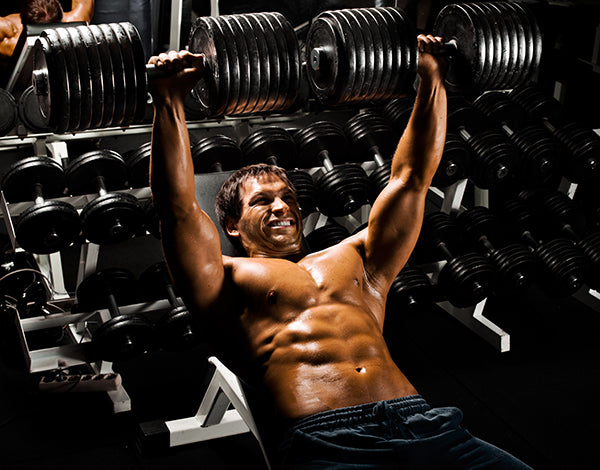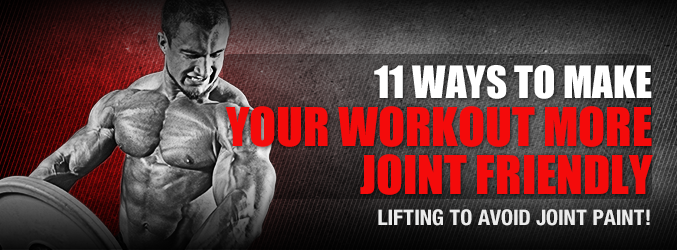
Genetically speaking, we were never really designed to be bodybuilders. Our ancestors that survived and reproduced were really more of the hunter & gatherer variety. They were long, skinny, and able to walk many miles, subsiding on a Paleo-type diet as they traveled around looking for food.The bigger ones of the bunch were usually slower than the predatory animals, so their bloodlines didn't always make the cut.
As a result, we arrive in the 21st century with a preordained physique more fit for soccer than for competitive powerlifting of bodybuilding. But that's okay - rules were made to be broken. We understand that it'll require a lot of hard work, but that we can change our body's look and performance ability through steady weight lifting of a progressive nature, coupled with high calorie intake and plenty of rest. Your muscles will grow to meet the demand. Your joints, however, are a whole different story!
Your joints move your muscles and bones. Without them, there is no lift. And they do grow quite sore as age takes its toll and you continue training with heavier and heavier weights for months, years, and decades at a time. Pain and injuries to your joints can immediately sideline you from the gym. We tend to endure joint pain and "tough it out" because the alternative is just to not lift at all. Or we live on painkillers and anti-inflammatory medicines to keep the pain down - also a very bad idea.
Many lifters enter the world of tendonitis, arthritis, bursitis, and many other "itis's" far too soon. You can help to prevent your entry into this club by lifting a bit smarter. Let's check out some tips & triceps for lifting to avoid joint paint!

Find alternatives
This is a simple rule which many lifters tend to overlook in the name of machismo. If it hurts, don't do it! If a movement is causing you pain and other joint issues, work to find another movement which taxes the muscle group in a similarly brutal fashion, without aggravating the sore joint. You should not abandon heavy compound movements in favor of light isolation work. Rather, find other heavy compound work which attacks the muscle group from different angles but still provides an adequate stimulus for muscle growth.
Keep it smooth
If there is a single inkling of injury or joint soreness, your form should be absolutely perfect when training. Momentum is NOT your friend if you suffer from joint inflammation. Excess weight on a joint, as well as added momentum energy can further aggravate a sore area. Keep your repetitions slow, controlled and safe, forcing the muscle group itself to conduct the hard work.

Opt for free weighs over machines
Often, our muscle groups have been locked into a single, stagnant arc for lifting motion for decades at a time, thanks to the fixed nature of machines. Switching to free weights means your stabilizer muscles come into play, pulling some tension off of the joints and allowing your body to naturally and comfortably compensate for any innate weakness. Give your joints a new freedom of motion and greater range while lifting - the results may be outstanding!
Warm ups matter
Without a doubt, you've probably heard for years that a warm up session is very important for the lifters. And you've probably arrived in the gym many times, noticed a bench press or squat rack open up, and quickly jumped on it, skipping the 5 to 10 minutes of walking or pedaling needed to get your joints ready for heavy lifting. Yes, it is nice securing a flat bench on a Monday (Universal Chest Day) at 5:30 PM. But it'd also be nice if your joints were prepared for the upcoming bench press training. Warm up, stretch, and use 1-3 light sets of each exercise before moving on to the heavy stuff!

Time under tension
Training to failure can yield some terrific results. It can also leave a lifter with seriously sore joints. The muscles don't know what you're putting your joints through. They just know how much time under tension, the workload they encounter, that they have had to face down. Try adding intensity to your workouts, while limiting the amount of sets which are pushed to the absolute limit. Your muscles grow from a variety of training approaches - but your joints grow very sore from the failure training. If you're sore a lot, you should limit the training to failure.
Pre-exhaust to a break!
For the muscle groups of the body, pre-exhaust training is a particularly brutal means of first isolating a muscle group with a very specific targeted movement, and then finishing it off with a powerful and heavy compound movement. The muscles you're targeting are hit in a very effective manner. This is an added intensity strategy, used to inspire new muscle growth. And it has the added benefit of actually being BETTER for the joints of the body than straight up heavy sets. The joints at taxed very little in the isolation set. Then the muscles fail early on in the compound heavy set, meaning you're setting that weight back down before the joints enter the danger zone. Give it a shot!

Avoid the lockout
Most of us push up a weight on any given movement to the point of lockout. It gives out muscles a temporary moment of rest, and delivers a nice rewarding second to breathe. However, this moment of rest comes at an expense. The workload is transferred from the targeted muscle group, to the joints supporting that lift. If your joints have been taking a beating and you wish to lighten their workload, stick with a training day with zero to minimal lockouts. You'll discover a better workout as well, since it means the muscles are doing more work than usual!
Add intensity slowly
There's nothing wrong with boosting your training intensity using new methods (such as down-the-rack) or increasing the amount of weight you are using for sets. The key to success is to do so gradually, so that your joints are never abruptly slammed with a workload addition of 10 to 20% increase they have never encountered before. Start slowly into heavier loads and creative training systems, and your joints will acclimate to the new demand accordingly.


